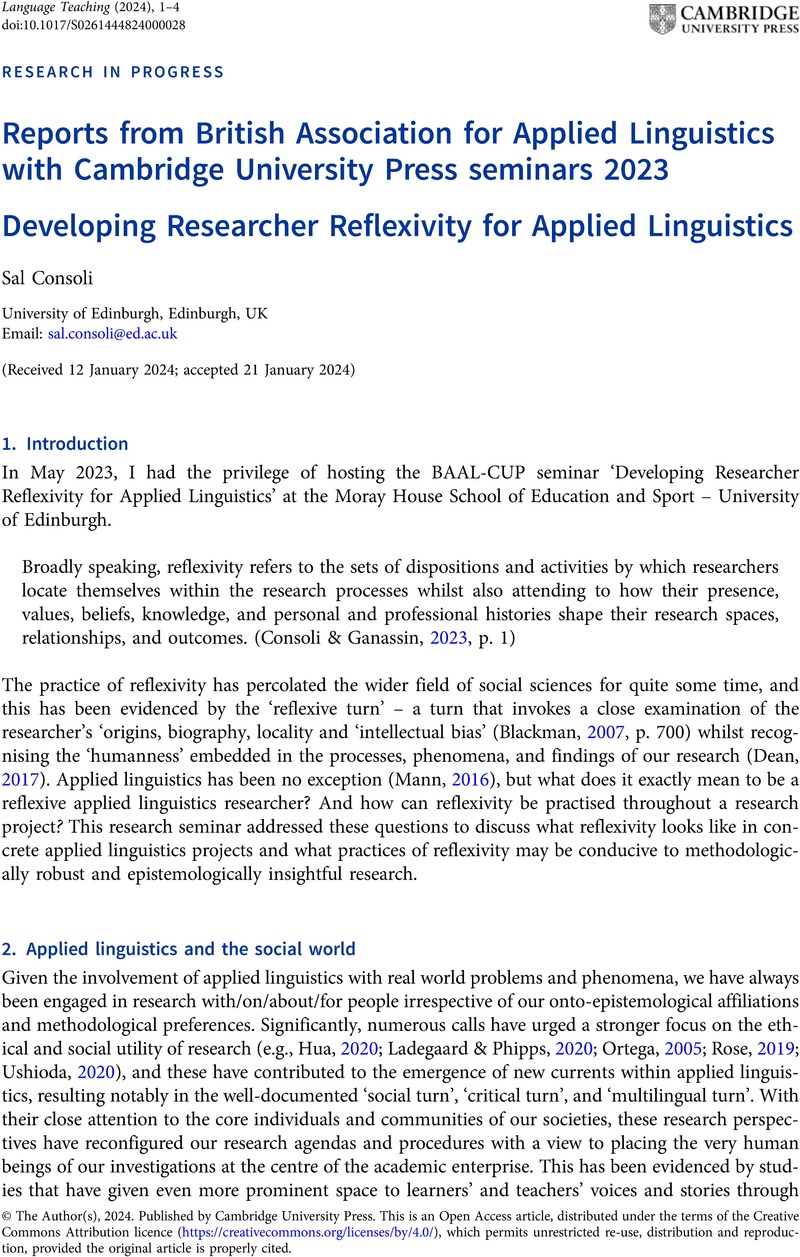No CrossRef data available.
Article contents
Reports from British Association for Applied Linguistics with Cambridge University Press seminars 2023 Developing Researcher Reflexivity for Applied Linguistics
Published online by Cambridge University Press: 23 February 2024
Abstract
An abstract is not available for this content so a preview has been provided. Please use the Get access link above for information on how to access this content.

- Type
- Research in Progress
- Information
- Copyright
- Copyright © The Author(s), 2024. Published by Cambridge University Press
References
Bhatt, I. (2023). A semiotics of Muslimness in China. Cambridge University Press. (Series: Elements in Applied Linguistics), doi:10.1017/9781009415910Google Scholar
Blackman, S. J. (2007). Hidden ethnography: Crossing emotional borders in qualitative accounts of young people's lives. Sociology, 41(4), 699–716. doi:10.1177/0038038507078925CrossRefGoogle Scholar
Consoli, S. (2022a). Life capital: An epistemic and methodological lens for TESOL research. TESOL Quarterly, 56(4), 1397–1409. doi:10.1002/tesq.3154CrossRefGoogle Scholar
Consoli, S. (2022b). Practitioner research in a UK pre-sessional: The synergy between exploratory practice and student motivation. Journal of English for Academic Purposes, 57, 101108. doi:10.1016/j.jeap.2022.101108CrossRefGoogle Scholar
Consoli, S., & Ganassin, S. (Eds.) (2023). Reflexivity in applied linguistics: Opportunities, challenges, and suggestions. Routledge.Google Scholar
Ganassin, S. (2020). Language, culture and identity in two Chinese community schools. Multilingual Matters.Google Scholar
Ganassin, S., & Holmes, P. (2020). ‘I was surprised to see you in a Chinese school’: Researching multilingually opportunities and challenges in community-based research. Applied Linguistics, 41(6), 827–854. doi:10.1093/applin/amz043CrossRefGoogle Scholar
Georgiou, A. (2022). Conducting multilingual classroom research with refugee children in Cyprus: Critically reflecting on methodological decisions. In Holmes, P., Reynolds, J., & Ganassin, S. (Eds.), The politics of researching multilingually (pp. 111–130). Multilingual Matters.CrossRefGoogle Scholar
Holmes, P. (2014). Researching Chinese students' intercultural communication experiences in higher education: Researcher and participant reflexivity. In Byrd Clark, J. S. & Dervin, F. (Eds.), Reflexivity in language and intercultural education: Rethinking multilingualism and interculturality (pp. 100–118). Routledge.Google Scholar
Holmes, P., Fay, R., Andrews, J., & Attia, M. (2013). Researching multilingually: New theoretical and methodological directions. International Journal of Applied Linguistics, 23(3), 285–299.CrossRefGoogle Scholar
Holmes, P., Fay, R., Andrews, J., & Attia, M. (2016). How to research multilingually: Possibilities and complexities. In Hua, Z. (Ed.), Research methods in intercultural communication (pp. 88–102). Wiley.Google Scholar
Hua, Z. (2020). Making a stance: Social action for language and intercultural communication research. Language and Intercultural Communication, 20(2), 206–212.CrossRefGoogle Scholar
Jackson, J. (2014). The process of becoming reflexive and intercultural: Navigating study abroad and reentry experience. In Byrd Clark, J. S. & Dervin, F. (Eds.), Reflexivity in language and intercultural education: Rethinking multilingualism and interculturality (pp. 43–63). Routledge.Google Scholar
Ladegaard, H., & Phipps, A. (2020). Intercultural research and social activism. Language and Intercultural Communication, 20(2), 67–80. doi:10.1080/14708477.2020.1729786CrossRefGoogle Scholar
Mann, S. (2016). The research interview: Reflective practice and reflexivity in research processes. Palgrave Macmillan.CrossRefGoogle Scholar
Ortega, L. (2005). For what and for whom is our research? The ethical as transformative lens in instructed SLA. Modern Language Journal, 89(3), 427–443. doi:10.1111/j.1540-4781.2005.00315.xCrossRefGoogle Scholar
Rebolledo, P., Smith, R., & Bullock, D. (Eds.). (2016). Champion teachers: Stories of exploratory action research. British Council.Google Scholar
Rose, H. (2019). Dismantling the ivory tower in TESOL: A renewed call for teaching-informed research. TESOL Quarterly, 53(3), 895–905. http://www.jstor.org/stable/45214962CrossRefGoogle Scholar





